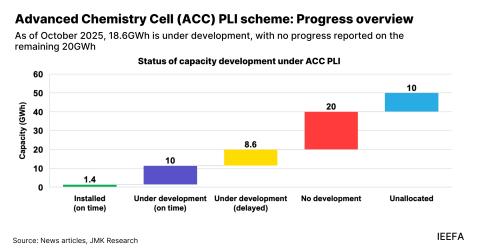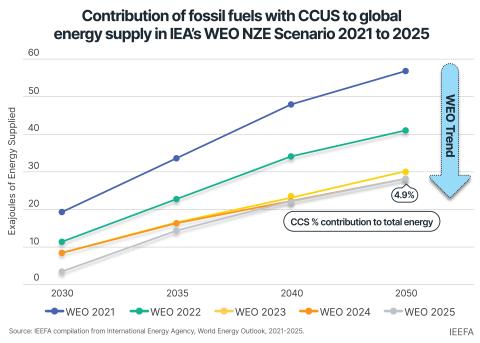IEEFA Update: Budget 2021-22 is a ‘mixed bag’ for India’s energy transition
Finance Minister Nirmala Sitharaman’s “development” budget for the fiscal year (FY) 2021-22 aims to build Indian infrastructure, enhance manufacturing and generate employment, plus drive discom reform, all of which will lay a strong foundation for economic growth and for limiting the fiscal deficit.
However, budget 2021-22 is a mixed bag in terms of support for India’s transition to a sustainable, low carbon economy. The Coal Ministry’s budget allocation for FY2021-22 for exploration of coal and lignite is down ~15% on FY2020/21. This is a welcome move. What is even more welcome is the huge cut to the budget allocated to the Ministry of Petroleum and Natural Gas, which is 63% lower than it was in FY2020/21. The lower allocation to the oil and gas sector could be on account of lower global prices and government reform initiatives such as eliminating subsidies on kerosene.
The government has announced a welcome infusion of Rs2,500 crore (US$0.3bn) for Solar Energy Corporation of India Limited (SECI) and Indian Renewable Energy Development Agency Limited (IREDA). It has increased custom duties on solar lanterns and inverters to boost domestic manufacturing. It has also launched the National Hydrogen Mission which, like the Solar and Storage missions, will be instrumental in the development of this exciting new technology.
What is missing?
The budget lacks support for the closure of inefficient coal-fired power plants. Given the state of surplus capacity and low plant load factors (PLFs), the distribution companies (discoms) should work with state governments to retire legacy, inefficient and expensive thermal power plants as a key pathway to reducing their average cost of power procurement. Other support measures like tax holidays, tax incentives and access to finance are also required to give a fillip to domestic manufacturing of solar components.
Solar industry players will be disappointed that the budget announcements did not include an exemption from or streamlining of Goods and Services Tax (GST) for renewable energy installations. They had wanted, at the very least, a change in the current goods to services ratio in GST calculation of 70:30 to 90:10. However, the government did not pay heed to such demands. Solar is the new ruler of the Indian electricity market and will help India to achieve its renewable energy target.
Solar is the new ruler of the Indian electricity market.
The government has allocated Rs3 lakh crore (US$40.5bn) to discoms which are the backbone of the power sector. The funds will build infrastructure including smart metering, feeder segregation and upgradation of systems to reduce losses and improve efficiency. This is a very necessary action to remove a key break on sustained economic growth.
While discom reforms are critical, past experience shows that simply pumping in more money does not improve the discoms’ operational and financial performance. Absence of political will and competition, coupled with corruption and red tape, unsustainable cross-subsidies, economically inefficient tariff-setting processes, expensive thermal power purchase agreements (PPAs), and lack of modern technology and infrastructure development are adding to discom losses.
The fiscal debt limit should be linked to the performance of discoms. All access to central government funds by way of grants, subsidies, loans etc. should be linked to improvement in the discoms’ performance ratings. If a state discom fails to improve its rating, fiscal access should be restricted.
In the transport sector, the budget allocates Rs 18,000 crore (US$2.4bn) for augmentation of public bus services, but doesn’t say whether it will be for electric vehicles (EVs). The government has also announced a vehicle scrappage policy, which may encourage a switch to more efficient vehicles. But the government could do more to tackle CO2 emissions by providing an incentive to replace scrapped vehicles with EVs.
India already has problems with air pollution and dependence on imported oil. EVs, while reducing local air pollution, shift the source of emissions to the site of electricity generation. Given the increasing share of renewable energy in India’s total electricity generation, EVs will reduce carbon emissions.
There is a sum of Rs2,217 crore (US$0.3bn) allocated to tackle air pollution – but it is a reduction of 50% compared to the Rs4,200 crore (US$0.6bn) allocated in last year’s budget. Moreover, this fund was underutilised and there is a lack of monitoring and accountability.
To ensure it is used for its intended purpose, there should be transparency on how the fund is being utilised and state allocation from the central budget next year should be conditional on improvement in air quality in the cities in those states.
The government is also extending the timeline for compliance of emission norms by power plants, which is a major cause of pollution. Air pollution is a public health emergency in India – delaying action will cost millions of lives.
Easing the burden of nonperforming assets
In addition to government budgetary allocation, India needs a strong financial system with more funding available for the transition to a low carbon economy. The government has announced monetisation of transmission assets worth Rs7,000 crore (US$0.9bn) which would free up resources to fund new and under-construction greenfield projects. Further, government has announced Development Finance Institutions (DFIs) with an initial corpus of Rs20,000 crore (US$2.7bn). This is not for the power sector alone but it is likely that a DFI will facilitate access to long term debt financing to the infrastructure sector including the power sector, a key enabler of renewable projects to drive electricity price deflation.
India needs large amounts of global capital to meet its renewable energy targets.
The government has also announced the Asset Reconstruction Company and Asset Management Company to help banks tackle bad loans. India’s thermal generation sector is carrying US$40-60 billion in nonperforming or stranded assets supported by the troubled banking sector. The formation of these companies will help to tackle the burden of nonperforming assets in the power sector.
India needs to access large amounts of global capital to meet its energy security, renewable energy targets and reduce energy intensity to meet its Intended Nationally Determined Contributions (INDCs). While most countries are not on course to meet their Paris Agreement goals, India is progressing well, with 91 gigawatts (GW) of installed renewable energy capacity as of December 2020. However, to achieve our renewable energy ambitions, a stable policy environment is a must (reneging on solar PPAs creates sovereign risk). What we need is a holistic approach to the energy transition, where the push for renewable energy is accompanied by support for a faster phase out of fossil fuels.
Vibhuti Garg is an Energy Economist at IEEFA.
Related items:
IEEFA Webinar: How India’s new net metering restriction could impact the rooftop solar market
IEEFA Update: Is India ready to compete with China in solar module production?















